How to Get More Traffic: 9 Key SEO Lessons for 2018 and Beyond
These notes are a summary of Rand Fishkin’s talk at WooConf 2017. Rand is the founder and former CEO of Moz. He is widely regarded as one of the foremost experts on SEO in the world and is the author of the popular The Beginner’s Guide to SEO that has been read over 3 million times! See more WooConf 2017 talk summaries here.

1. Google Has Taken a Decisive AI and Machine Learning First Approach
Google had an internal debate for a long time about using AI versus not. There were two warring camps inside the company. They have now decided to be AI first.
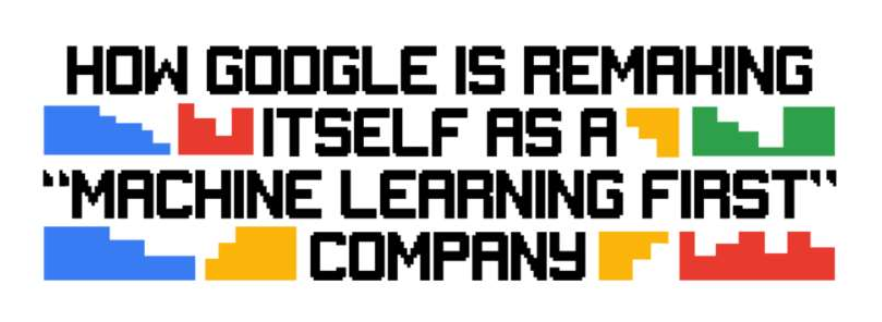
Two recent breakthroughs in their use of AI are improvements in divining searcher intent (rather than the literal keyword phrase) and their ability to accurately assess visitor engagement and use it as a ranking factor. See the next two points below.
2. Google Has Become Masterful at Divining The Searcher’s Intent
Known as “semantic search” in the industry jargon, searches like “book about Jews living in Alaska” will return as its first result The Yiddish Policeman’s Union, a popular book about Jews living in Alaska.
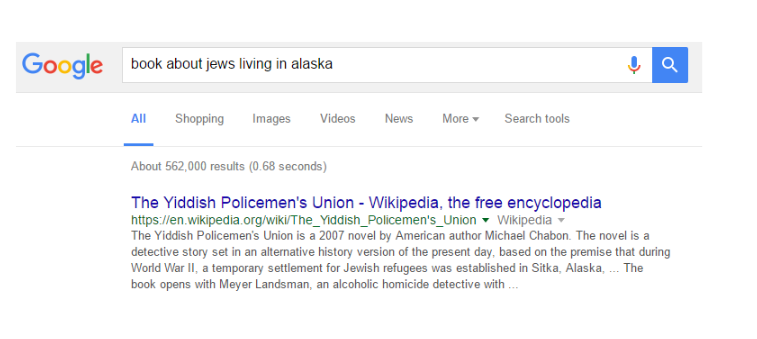
Similarly, Google divines that you really mean “Stonehenge” when you search for “famous circle of big rocks”

This is a huge improvement from the early days of search. Anyone old enough to remember when AltaVista would return the page that had the highest concentration of “book about Jews living in Alaska” phrases?
3. Searcher Engagement May Be the New Silver Bullet in Rankings
Google now takes into account how much time people spend on your site and if they share, comment or engage in any other way.
If searchers bounce (spend less than a few seconds) from your pages, over time your rankings will decline. On the other hand, if searchers never need to go to the second result after visiting your page, you will stay number one.
In other words, if users rarerly engage in “pogosticking” (technical term) on your site, the Google gods will continue to look upon you favorably!
Codecademy (which is free) is the gold standard for the type of site that is faring well under Google’s new ranking algorithm.
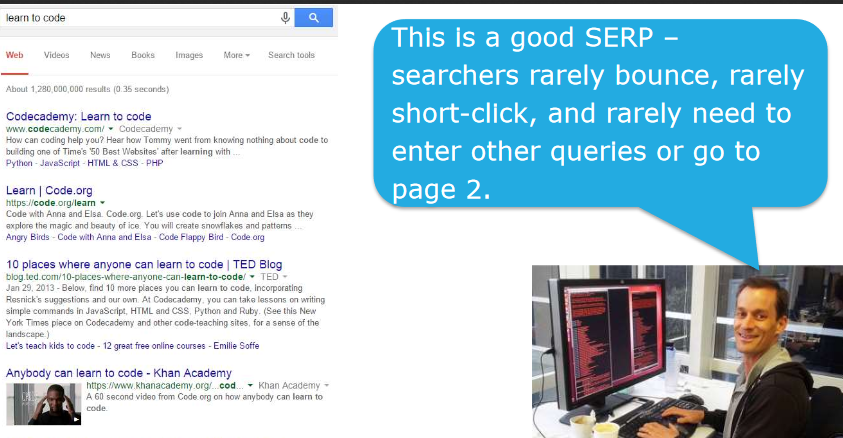
No matter how clever bot traffic gets, Google’s AI is one step a head. We bought and tested a couple of Fiverr gigs where they promised us “low bounce rate” organic traffic. True to their promise, it was low bounce (like really unnaturally low, at about 5%!) but it was all bot traffic. Google correctly detected this.
Google’s new RankBrain is behind this initiative.

Rand recommended making UX a Cornerstone of Your SEO:
• Have authoritative, comprehensive content that’s uniquely valuable vs. what anyone else in your space provides. But how does one stand out in the suffocating sea of all the new long form high quality content? While Seth Godin continues to get viral hits for little more than one-liners, everyone seems to producing 3,200 word high quality articles!
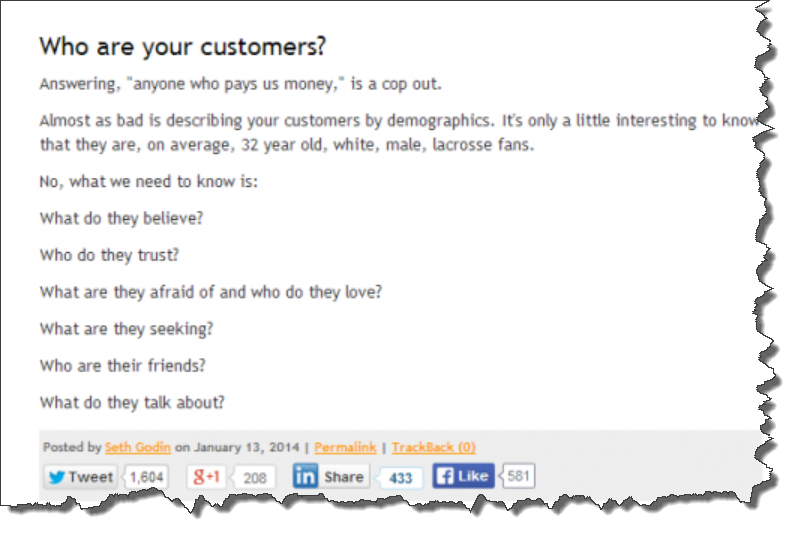
Image source: OkDork via Peep Laja
• Speed, speed speed. Google’s RankBrain also factors in load speed by virtue of the fact that users bounce if your page does not load fast especially on Mobile. Lisa Wang [link] talked about this extensively in her talk about Google’s project amp. Cite stats from her talk.
• Deliver an easy enjoyable experience on every device. In other words do the right thing your users and Google will reward you. Avoid “clever hacks”.
• Avoid features that annoy users. You might want to re-think that email popup that has a 0.25% conversion rate but that annoys the hell out of users and causes a high bounce-rate!
4. AdWords is redacting data like it’s the CIA.
It used to be that when you used Adwords to do keyword search, you got rich data around search volume for specific keywords down to the longest tail, lowest volume ones. Now Google is rolling up the volume for groups of related keywords and showing one figure.
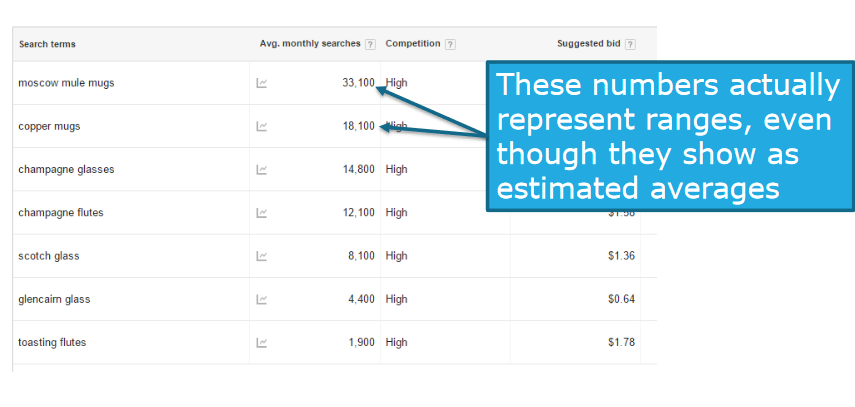
Apparently they are doing this to force users to spend more on AdWords. The more you spend, the more data that is accessible in your accounts view, as Nick Eubanks writes. Is Google killing the goose that lays the golden eggs? When you lord it over users like this it is only a matter of time before they find an alternative.
5. Paid Search Spending Continues to Level Off:
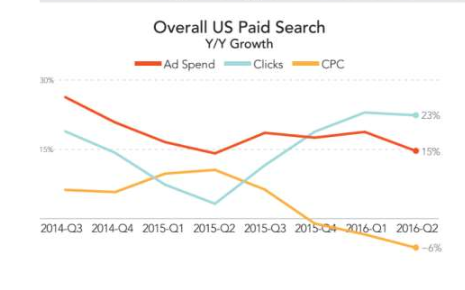
Total paid search spending grew 15% year over year in Q2 of 2016 down from 19% in Q1. Google has fought back by making the ads subtler and more like the organic links so that there is less of a discernible difference between the two.
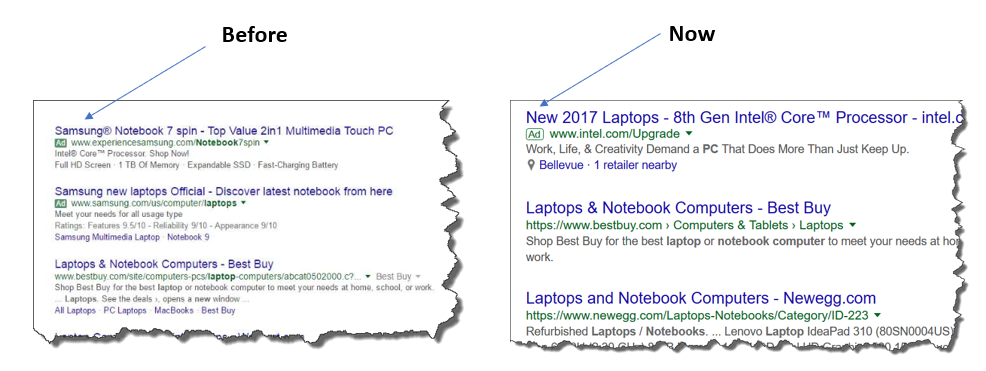
Where next from here? My guess? Maybe a tiny asterisk on the ad and 3-pt font print at the bottom of the page explaining it is an ad!
6. If most of your traffic comes from Google you better actively start diversifying it.
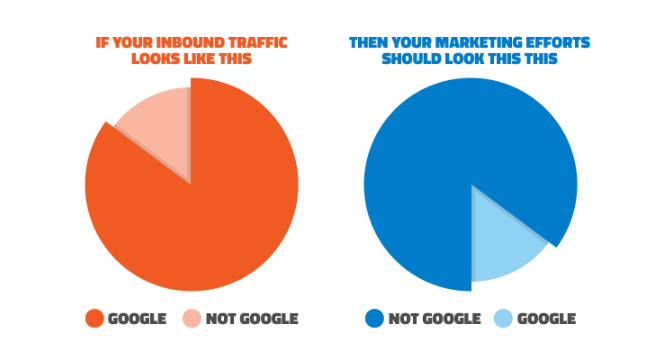
You’ve invested in SEO over the years and now the Google Gods have blessed you with floodgates of free traffic. All the techniques you’ve used are white hat so you’ve got nothing to worry about, right?
Think again. If Google determines that 80% of your traffic is coming from them they will start taking a closer look at why. If you run Google analytics, they know the source of each click to your site.
Some tips for diversifying include:
• Get more social traffic by optimizing social shares. There a lots of social share plugins but the very best ones can get you significantly more shares than just okay ones. We use Sumo and recommend it to our clients.
• Always be building your email list. Email traffic is one of the most reliable sources of web traffic. Whenever you publish new content, email your list and if you’ve done 1) above correctly, social sharing will amplify it and get you yet more traffic. The only problem is email opt-in and click through rates have fallen dramatically over the years. Again, there is an art to getting great results and Sumo has a whole guide on it. Here are some tips for getting higher open and click through rates.
• Find out where your competitors are getting traffic from and then invest in those sources.For example here is where WarbyParker.com gets most of its traffic from.
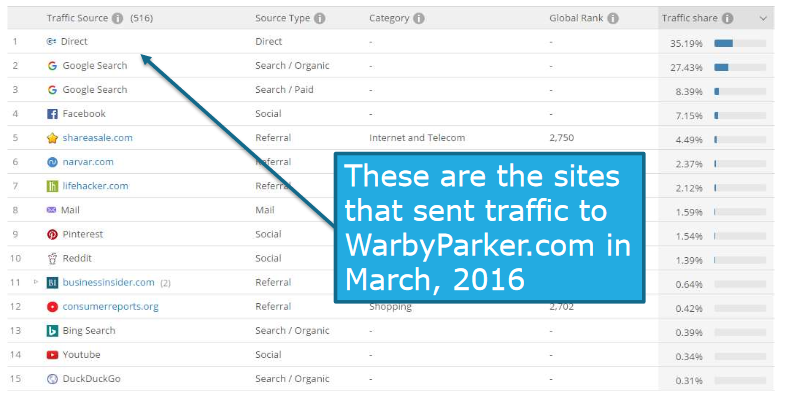
• Don’t Ignore a Search Engine Just because Its Google. DuckDuckGo Traffic Continues to grow and it may be the next big thing. By the way, DuckDuckGo is often celebrated as a triumph of the solo-preneur over “big, bad, corporate entities”.
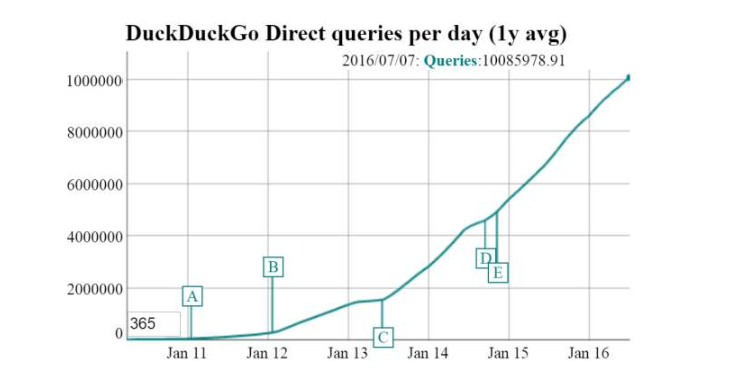
Bing Traffic, while considerably less than Google’s, converts a lot better. We’ve seen this in our own hobby fitness business and Perry Belcher of Traffic & Conversion Summit fame did a study with millions in ad spend over 23 different product categories.
Being number two, Bing (like in the old Avis ads) also tries harder when it comes to customer support. You can call and talk to a live human being, Bing support rep! Good luck trying to get a Google rep on the phone. They seem to want to run everything with algorithms.
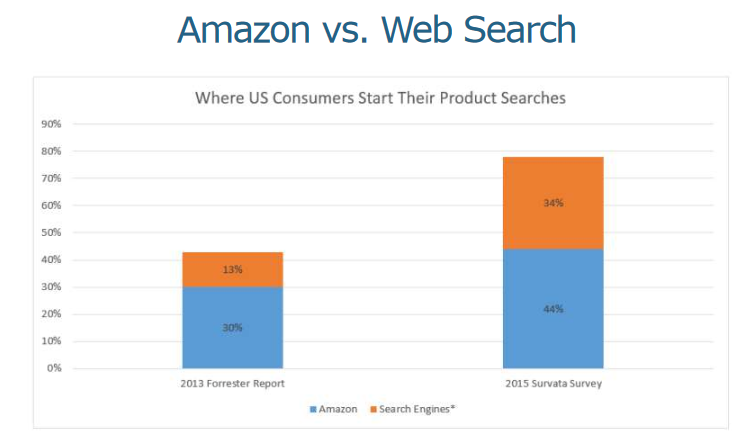
If you are selling any kind of product, you should also optimize for Amazon rankings as it can be an important source of traffic and Amazon searches are 3x as valuable [1] as Google searches. Amazon uses different factors explained here by Nathan Grimm.
7. Google’s Use of Content Excerpts aka Instant Answers Can Result In More Traffic
Ironically, Google’s use of “instant answers” i.e. taking excerpts of the content from the source site and displaying it on Google has resulted in more traffic for some, for example Moz.com
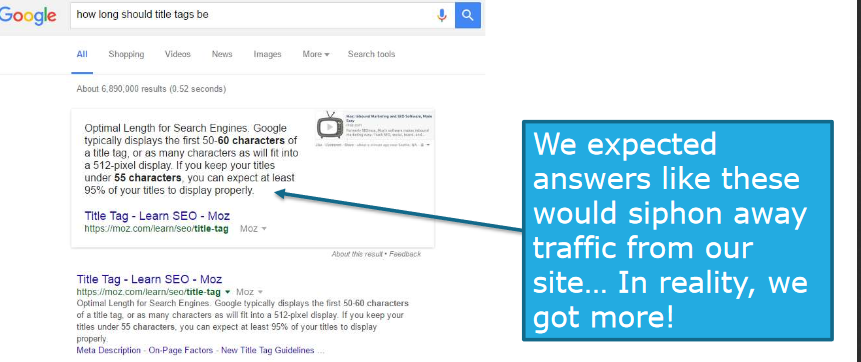
One way you can use SEO to take advantage of this is to write your content in the “instant answer” format the Google likes. In the example below The Coffee Shop Owners Guide beat out Wikipedia (with far more domain authority) for the search “coffee bean types” by doing this.
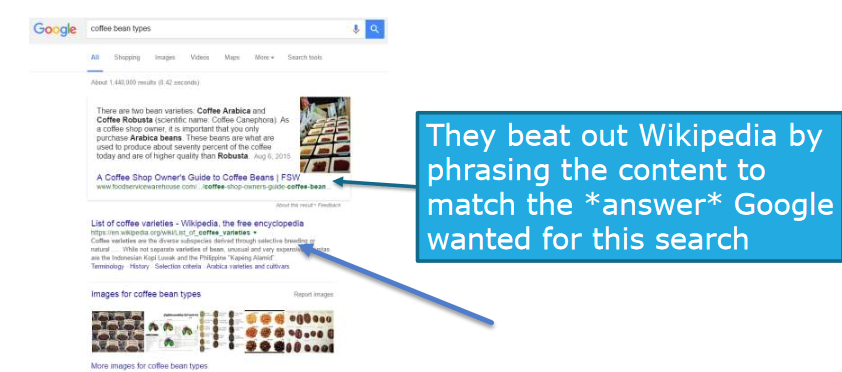
Online merchants are utilizing product Q&A content in order to get similar results and that has proven to increase ecommerce traffic, since Google's Instant Answers are in a great position to confirm product information and help convert sales. See an example here where somebody asking about a replacement part is lead to product Q&A content from a merchant who sells those products.
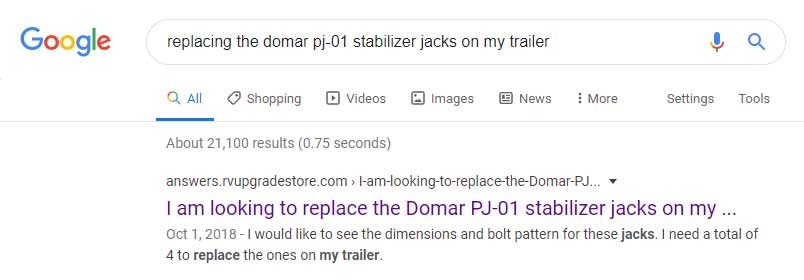
For location type searches, though, “instant answers” often leads to as much as 50% less traffic! See the example below.
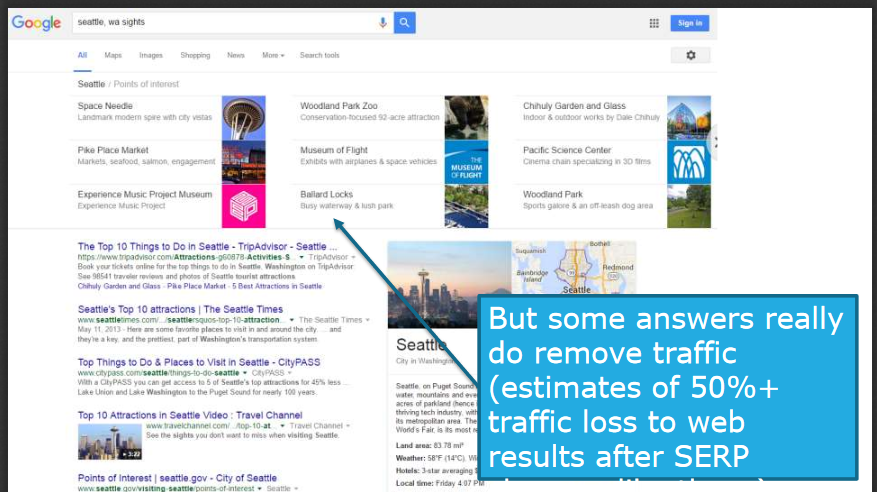
Anecdotally this is true for me. If I am searching for a place and Google shows me the instant answer, I never bother going to the source site.
Similarly, Googles Treatment of Image Search Has Reduced Traffic Across the board for most sites. In the screenshot below, clicking on an image thumbnail displays an enlarged image within Google rather than taking the searcher to the source site (the default behavior in the past).
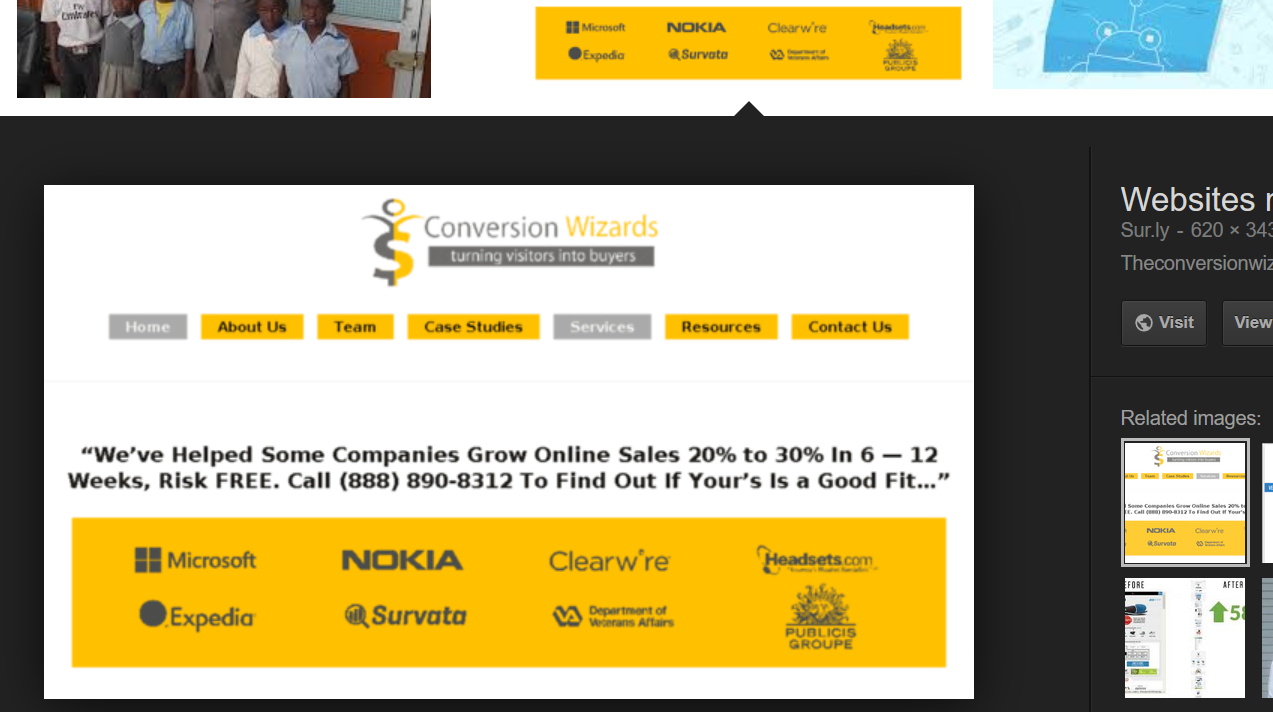
Rand suggested that one way to counter this is to embed text in your main images that encourages users to click through to your site. For example, you might embed the following text “from CapitalandGrowth.org. Visit our site to learn more”.
8. Google Restricts Who Can Appear in the Results for Certain Types of Searches
For example, for video results, only YouTube and Vimeo seem to appear for most sources. Again, this might be high-handed behavior by Google to force everyone to use YouTube or it could just be that there are just that many more YouTube videos.
On mobile results are only shown from Google Play and the AppStore for certain queries.
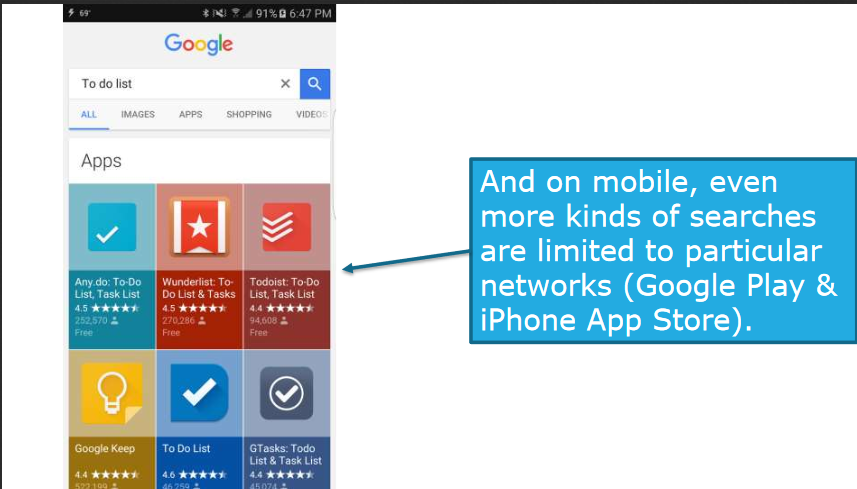
To fare well make sure you are in the right places for the keywords you care about.
9. Keyword Matching is No Longer a Competitive Advantage
It used to be that if your title tag matched the search term you would get ranked higher (versus a potential result that did not do this). But as shown in the graph below, it is a factor that is declining in importance.
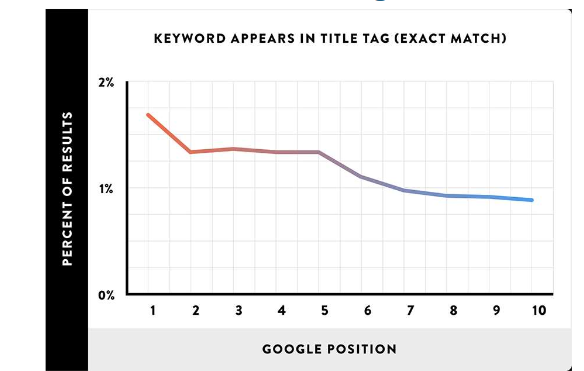
Takeaway: Don’t spend time tuning your title tags and descriptions to match keyword phrases. Just have high quality content and keywords that correlate highly with the actual search i.e. it does not have to be exact e.g. it is hard to talk about “growth hacking” without talking about traffic, users, startups etc. See Rand’s 8 principles of on-page SEO WhiteBoard Friday for more on this topic.
I wonder if this is true for hyperlinking as well? i.e. Is it now no longer important to have the keyword phrase in the hyper link for Google to deem the target site an authority on the topic?
Want to learn more? Get Rand’s deck here. You should also consider getting his The Beginner’s Guide to SEO that has been read over 3 million times.
Thanks to Hayk Saakian for reading drafts of this.

1. Google Has Taken a Decisive AI and Machine Learning First Approach
Google had an internal debate for a long time about using AI versus not. There were two warring camps inside the company. They have now decided to be AI first.

Two recent breakthroughs in their use of AI are improvements in divining searcher intent (rather than the literal keyword phrase) and their ability to accurately assess visitor engagement and use it as a ranking factor. See the next two points below.
2. Google Has Become Masterful at Divining The Searcher’s Intent
Known as “semantic search” in the industry jargon, searches like “book about Jews living in Alaska” will return as its first result The Yiddish Policeman’s Union, a popular book about Jews living in Alaska.

Similarly, Google divines that you really mean “Stonehenge” when you search for “famous circle of big rocks”

This is a huge improvement from the early days of search. Anyone old enough to remember when AltaVista would return the page that had the highest concentration of “book about Jews living in Alaska” phrases?
3. Searcher Engagement May Be the New Silver Bullet in Rankings
Google now takes into account how much time people spend on your site and if they share, comment or engage in any other way.
If searchers bounce (spend less than a few seconds) from your pages, over time your rankings will decline. On the other hand, if searchers never need to go to the second result after visiting your page, you will stay number one.
In other words, if users rarerly engage in “pogosticking” (technical term) on your site, the Google gods will continue to look upon you favorably!
Codecademy (which is free) is the gold standard for the type of site that is faring well under Google’s new ranking algorithm.

No matter how clever bot traffic gets, Google’s AI is one step a head. We bought and tested a couple of Fiverr gigs where they promised us “low bounce rate” organic traffic. True to their promise, it was low bounce (like really unnaturally low, at about 5%!) but it was all bot traffic. Google correctly detected this.
Google’s new RankBrain is behind this initiative.

Rand recommended making UX a Cornerstone of Your SEO:
• Have authoritative, comprehensive content that’s uniquely valuable vs. what anyone else in your space provides. But how does one stand out in the suffocating sea of all the new long form high quality content? While Seth Godin continues to get viral hits for little more than one-liners, everyone seems to producing 3,200 word high quality articles!

Image source: OkDork via Peep Laja
• Speed, speed speed. Google’s RankBrain also factors in load speed by virtue of the fact that users bounce if your page does not load fast especially on Mobile. Lisa Wang [link] talked about this extensively in her talk about Google’s project amp. Cite stats from her talk.
• Deliver an easy enjoyable experience on every device. In other words do the right thing your users and Google will reward you. Avoid “clever hacks”.
• Avoid features that annoy users. You might want to re-think that email popup that has a 0.25% conversion rate but that annoys the hell out of users and causes a high bounce-rate!
4. AdWords is redacting data like it’s the CIA.
It used to be that when you used Adwords to do keyword search, you got rich data around search volume for specific keywords down to the longest tail, lowest volume ones. Now Google is rolling up the volume for groups of related keywords and showing one figure.

Apparently they are doing this to force users to spend more on AdWords. The more you spend, the more data that is accessible in your accounts view, as Nick Eubanks writes. Is Google killing the goose that lays the golden eggs? When you lord it over users like this it is only a matter of time before they find an alternative.
5. Paid Search Spending Continues to Level Off:

Total paid search spending grew 15% year over year in Q2 of 2016 down from 19% in Q1. Google has fought back by making the ads subtler and more like the organic links so that there is less of a discernible difference between the two.

Where next from here? My guess? Maybe a tiny asterisk on the ad and 3-pt font print at the bottom of the page explaining it is an ad!
6. If most of your traffic comes from Google you better actively start diversifying it.

You’ve invested in SEO over the years and now the Google Gods have blessed you with floodgates of free traffic. All the techniques you’ve used are white hat so you’ve got nothing to worry about, right?
Think again. If Google determines that 80% of your traffic is coming from them they will start taking a closer look at why. If you run Google analytics, they know the source of each click to your site.
Some tips for diversifying include:
• Get more social traffic by optimizing social shares. There a lots of social share plugins but the very best ones can get you significantly more shares than just okay ones. We use Sumo and recommend it to our clients.
• Always be building your email list. Email traffic is one of the most reliable sources of web traffic. Whenever you publish new content, email your list and if you’ve done 1) above correctly, social sharing will amplify it and get you yet more traffic. The only problem is email opt-in and click through rates have fallen dramatically over the years. Again, there is an art to getting great results and Sumo has a whole guide on it. Here are some tips for getting higher open and click through rates.
• Find out where your competitors are getting traffic from and then invest in those sources.For example here is where WarbyParker.com gets most of its traffic from.

• Don’t Ignore a Search Engine Just because Its Google. DuckDuckGo Traffic Continues to grow and it may be the next big thing. By the way, DuckDuckGo is often celebrated as a triumph of the solo-preneur over “big, bad, corporate entities”.

Bing Traffic, while considerably less than Google’s, converts a lot better. We’ve seen this in our own hobby fitness business and Perry Belcher of Traffic & Conversion Summit fame did a study with millions in ad spend over 23 different product categories.
Being number two, Bing (like in the old Avis ads) also tries harder when it comes to customer support. You can call and talk to a live human being, Bing support rep! Good luck trying to get a Google rep on the phone. They seem to want to run everything with algorithms.
- Consider also optimizing for Amazon traffic:

If you are selling any kind of product, you should also optimize for Amazon rankings as it can be an important source of traffic and Amazon searches are 3x as valuable [1] as Google searches. Amazon uses different factors explained here by Nathan Grimm.
7. Google’s Use of Content Excerpts aka Instant Answers Can Result In More Traffic
Ironically, Google’s use of “instant answers” i.e. taking excerpts of the content from the source site and displaying it on Google has resulted in more traffic for some, for example Moz.com

One way you can use SEO to take advantage of this is to write your content in the “instant answer” format the Google likes. In the example below The Coffee Shop Owners Guide beat out Wikipedia (with far more domain authority) for the search “coffee bean types” by doing this.

Online merchants are utilizing product Q&A content in order to get similar results and that has proven to increase ecommerce traffic, since Google's Instant Answers are in a great position to confirm product information and help convert sales. See an example here where somebody asking about a replacement part is lead to product Q&A content from a merchant who sells those products.

For location type searches, though, “instant answers” often leads to as much as 50% less traffic! See the example below.

Anecdotally this is true for me. If I am searching for a place and Google shows me the instant answer, I never bother going to the source site.
Similarly, Googles Treatment of Image Search Has Reduced Traffic Across the board for most sites. In the screenshot below, clicking on an image thumbnail displays an enlarged image within Google rather than taking the searcher to the source site (the default behavior in the past).

Rand suggested that one way to counter this is to embed text in your main images that encourages users to click through to your site. For example, you might embed the following text “from CapitalandGrowth.org. Visit our site to learn more”.
8. Google Restricts Who Can Appear in the Results for Certain Types of Searches
For example, for video results, only YouTube and Vimeo seem to appear for most sources. Again, this might be high-handed behavior by Google to force everyone to use YouTube or it could just be that there are just that many more YouTube videos.
On mobile results are only shown from Google Play and the AppStore for certain queries.

To fare well make sure you are in the right places for the keywords you care about.
9. Keyword Matching is No Longer a Competitive Advantage
It used to be that if your title tag matched the search term you would get ranked higher (versus a potential result that did not do this). But as shown in the graph below, it is a factor that is declining in importance.

Takeaway: Don’t spend time tuning your title tags and descriptions to match keyword phrases. Just have high quality content and keywords that correlate highly with the actual search i.e. it does not have to be exact e.g. it is hard to talk about “growth hacking” without talking about traffic, users, startups etc. See Rand’s 8 principles of on-page SEO WhiteBoard Friday for more on this topic.
I wonder if this is true for hyperlinking as well? i.e. Is it now no longer important to have the keyword phrase in the hyper link for Google to deem the target site an authority on the topic?
Want to learn more? Get Rand’s deck here. You should also consider getting his The Beginner’s Guide to SEO that has been read over 3 million times.
Thanks to Hayk Saakian for reading drafts of this.



